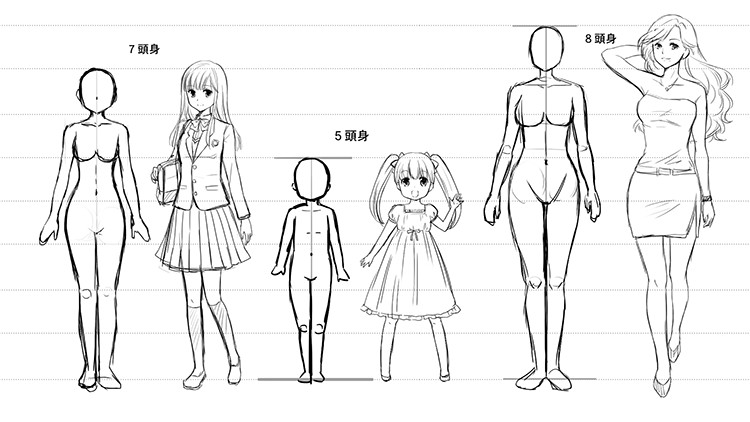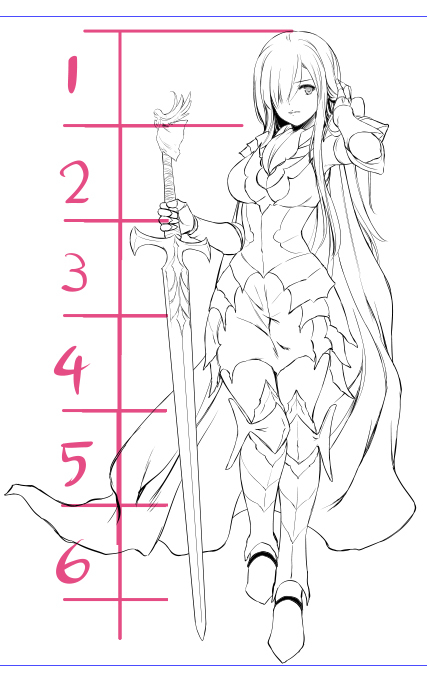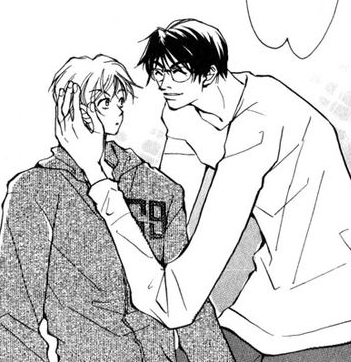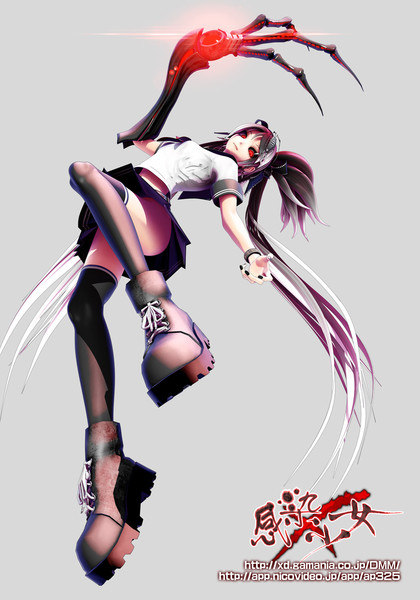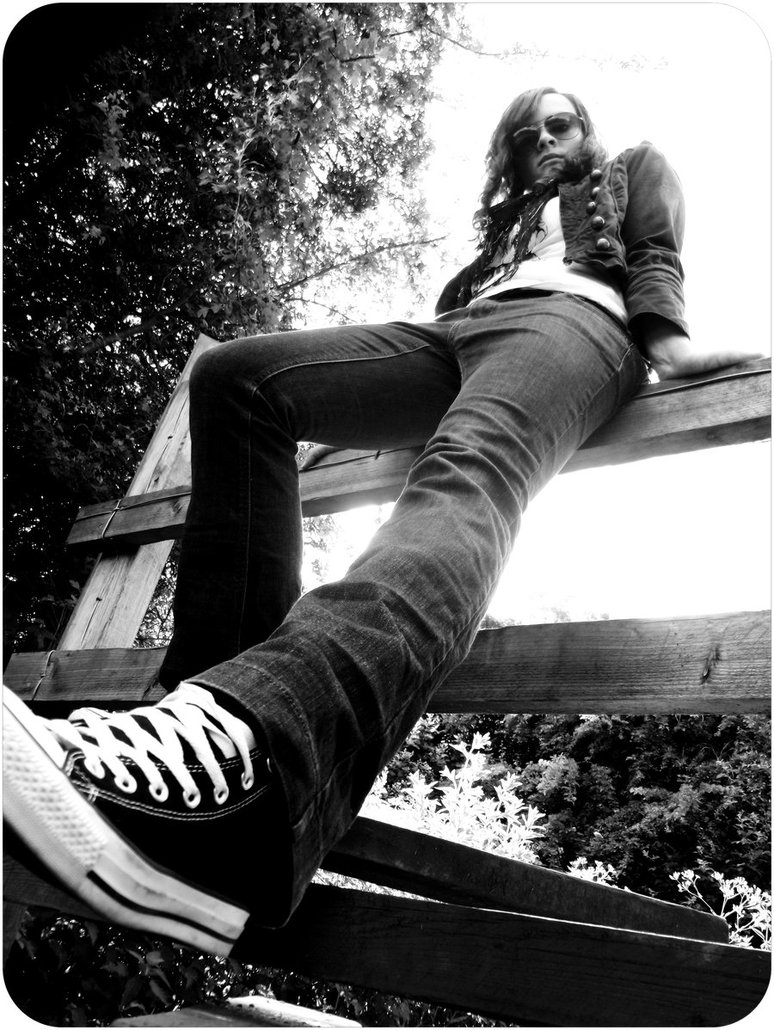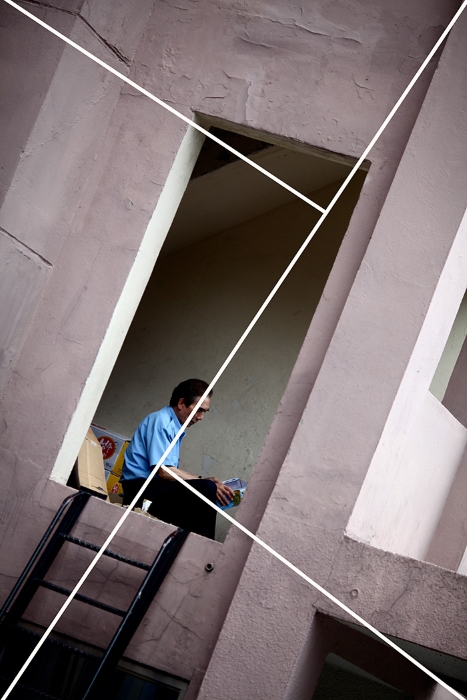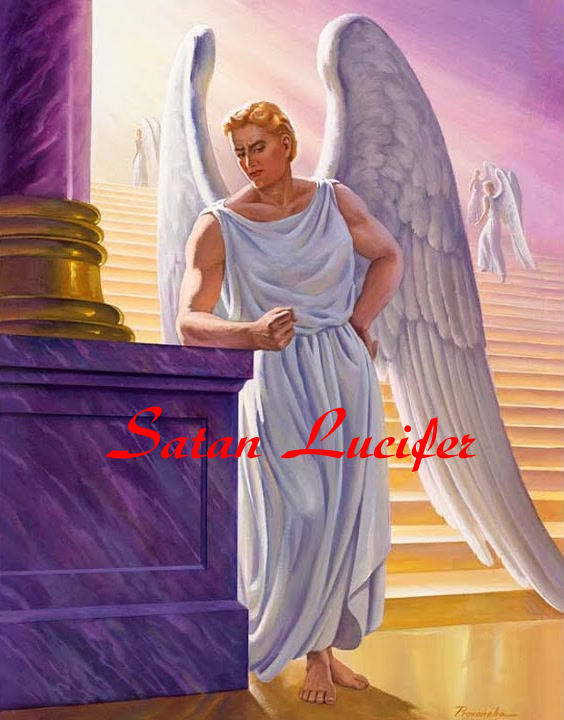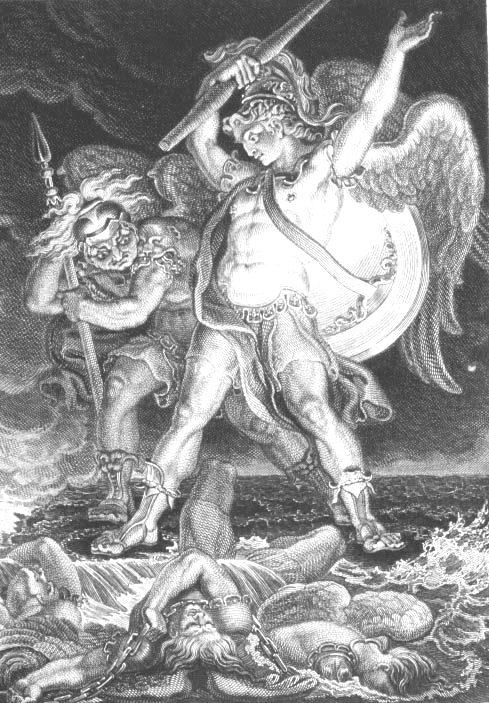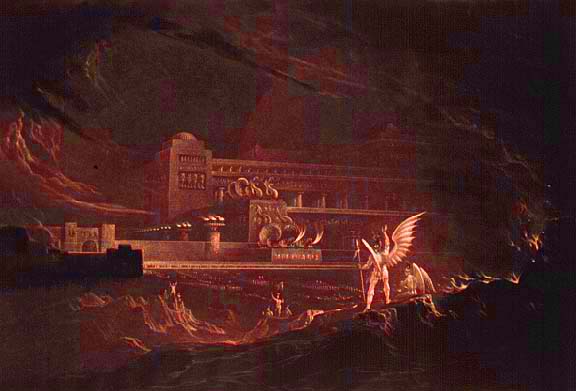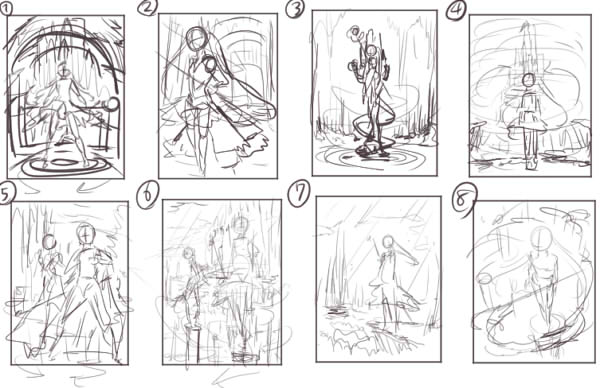OhNoItsMook
Member
- Joined
- Sep 28, 2017
- Messages
- 191
Prelude
Powerofjustice's recent thread regarding the concept of giving and taking, has allowed me to come to the realization that I have very much held back from providing the knowledge I possess in my area of expertise, to the forums for many years.
However, with the recent creation of this sub-forum of Art & Music, I may now finally have a place to contribute the knowledge and experience I've accrued over my years, towards helping our community learn and develop in my own field of passion, that being art.
Specifically, digital illustration of human characters, and backgrounds. Nevertheless, the same knowledge and fundamentals also apply to traditional art (pencil & paper, watercolor, markers etc), and even other genres of drawing (mechas, animals, probably...). Interestingly enough, most of us started on paper before moving onto digital art, and there are still many professionals among us who sketch on paper and then scan and finalize their art digitally.
As you may or may not have seen me before on these forums, please allow me to provide an in-depth and definitely not vague introduction before I commence the deluge of information I'd been anticipating to share here for over 4 years.
Mook, Artist.
Now that we've totally gone over the full details of my entire identity, let me explain to you the absolute fundamentals of art that a beginning artist must focus on, at the very start of their eternal adventure that is the expression of our emotions and soul. Many artists in the beginning may possess a strong desire to begin learning illustration, but do not know how, or where to start. Surely, they wouldn't even have a painting program or a digital illustration device for it.
However, as I mentioned earlier, mostly all of us started with pencil and paper, and since the fundamentals are the same, it will actually carry over into digital art, once you get past the initial potential discomfort of using a pen and tablet, if you ever choose to go digital.
If you happen to like RPG games, think of art like an online RPG. Everyone starts with default equipment corresponding to their class, and everyone chooses their own path. Some branch out to different kinds of art, like music, or literature. Even in those different sectors of art, there's many genres of it underneath.
For example, illustration: Western comic style, Eastern anime/manga style, human characters, robotic/mechanical characters, creatures, etc.
Music: Rock, Jazz, Orchestra, etc.
Literature: Horror, mystery, romance, etc.
Since we're all literal mages in real life here, let's just say we're generally the Magician class as artists. It's very suiting, too, since the entire idea of art is to manifest in reality that which we express emotionally and psychologically, and from the soul level. What type of Magician you want to attribute your artistic identity to, I leave that to you.
With that said, let me introduce you to some of the fundamentals that will form as a basis for everything you do as you progress in your art journey. Spiritual Satanist is a very special mage class, and we have hidden, unique abilities that can help us in the acquisition of knowledge, and maybe even gain more EXP (and faster) compared to "normal" classes, or even "regular" mages...
The Fundamentals of Art (The Plains of Beginnings!)
#1 - Gesture Drawing (Slime) (Lv.1)
First and foremost, without exception, for the most part: Gesture/figure drawing. Figure drawing is the act of observing a pose from a photograph, and attempting to comprehend its forms of dynamism and movement through usage of the "line of action" (an imaginary line that runs through any pose, static or moving), and loose shapes such as circles and ovals to roughly represent parts of the body.
Understanding the flow of the human body in different poses from the very beginning, and how to capture it, ultimately already saves you from the first novice trap of trying to draw things without construction or dynamism.
The key to practicing and comprehending this, is to repeatedly perform figure drawing as a regular warm-up, under 2 minutes or less. As you become used to this process, you should aim to be able to mostly draw a loose pose of which the action you can visibly identify by its flows alone, within 30 seconds.
Here is an example depicting the concept of flow in poses.
Translation: What is the flow of the body?
(left) No flow
(right) with flow.
(Bottom text) Expressing the flow is important when posing!

(Source: Palmie.jp (https://www.palmie.jp/lessons/267)
There are many sites out there designed for artists to practice figure drawing. Personally, the two sites I've used for years where I have been able to effectively practice figure drawing, are Line of Action, and PoseManiacs. The former uses real photographs, the latter uses anatomical models, which I'll mention again later in this post.
An example of using photographs as reference when practicing figure drawing and poses:

Source: Pinterest
(Personal experience: I remember in the beginning, my first sketch with zero fundamentals took 6 hours and looked like splattered shit. I used all my mana just to defeat a slime that only gave 1 EXP, basically. Don't be like me. Always start from fundamentals)
Unique ability usage: Activate your third eye and tap into intuition as you observe the poses, and "feel" the flow. Every one of us sees and starts drawing from different parts of the pose, and constructs it differently. One of the most crucial elements of learning is intuitively discovering a method that suits you, individually, and our abilities help us understand ourselves enough to find exactly which way works best personally.
Also, understanding of gesture and shape applies to anything, not just humans:

(Source: https://ichi-up.net/2019/30)
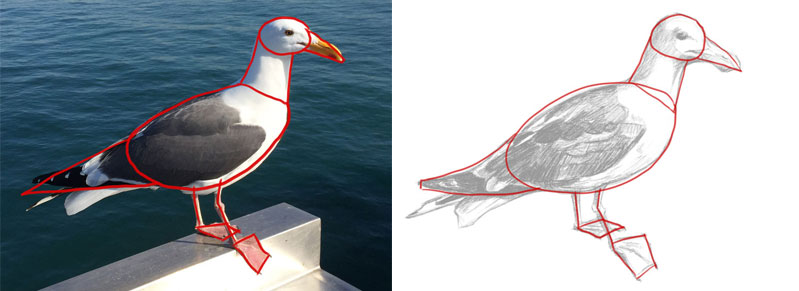
(Source: The Virtual Instructor)
#2 - Construction and 3d shapes (Rock Elemental) (Lv.2)
Here is an example portraying how the human body can be simplified into a combination of several different 3d shapes:

(Source: Clip Studio Paint tutorials)
The human body and any targeted subject, is constructed of complex forms that can be visually simplified and broken down into 3d shapes. For example, the head, torso and pelvis during the construction phase can generally be drawn as cubes, and the joints such as shoulders, elbows and knees simplified into spheres. The arms and legs, cylinders, and the hands and feet, as triangles, wedges or pentagons.
Once you understand how to visualize complex objects and structures as a combination of cubes, cylinders, spheres, cones and rectangles, and many other different 3d shapes, you can begin creating relatively comprehensible mannequins of humans, and anything else you wish to draw. As you become used to it, you'll realize most areas of the body or subject don't precisely conform to a certain shape. In these cases, like carving out a block, you gradually shape it into the part you intend to draw, as it begins to resemble your target more and more.
To familiarize yourself with drawing 3d shapes, try to draw all sorts of shapes and connect them on top or aside one another to obtain a feel as to how you might draw a real object in the future. Remember, everything can be simplified to a bunch of interconnected, stacked 3d objects. A closet, for example, is a rectangle with smaller rectangles for the handles. A door is a rectangle with a smaller rectangle and sphere for the doorknob.
Unique ability usage: After vividly observing the photograph of the subject (remember to use references), human or otherwise, close your physical eyes and use your astral sight to attempt to reconstruct what you just saw, as three-dimensional shapes. Entirely replicating what you see can be too hard at first and is also not the point here, so using your astral vision forces you to comprehend and construct something while also using both your creativity and intuition, as they tell you what stands out the most to you, and how to recreate it.
Construction will also help in visualizing things in perspective, which leads us to the next fundamental.
#3 - Perspective (Wind Elemental) (Lv.3) (Arguably level 666 or something once you cross into advanced levels...)
Perspective is the construction of the surrounding environment in which the subject is depicted, and also the space and distance perceived based on what is shown to be nearer, and farther away to the viewer. ...Yeah. This is a monster that scales with your own level, so it will almost always be difficult regardless of your level of advancement.
For now, let's just talk about how perspective can be incorporated into drawing characters. Backgrounds and the like are for the next chapter zone.
Understanding perspective is fundamental in depicting your subject in both a convincing and visually appealing manner, as we begin to include how the viewer visually perceives the subject in space, and this can possess a major impact in the expressiveness and mood of the illustration. You may have heard of foreshortening, which is typically when part of the character seems to reach out towards the viewer, like their hand, or foot. This is already somewhat advanced usage of perspective on the character alone, excluding how perspective can be used for backgrounds and the like, too.
Similarly to film and photography, a character viewed from somewhat far away can create a feeling of distance, or isolation. Whereas a close up, perhaps diagonal shot of the character's face can be much more impactful and dramatic in conveying their emotions, and expression. This is one example of the usage of perspective to convey different moods.
Here is an example displaying how different angles of the same general action and character, can create very different expressions depending on the artist's usage of perspective:

(Source: Wacom tutorials)
One way to familiarize oneself with incorporating perspective into one's illustrations, is to practice drawing 3d shapes and objects in different angles. Eventually, you will want to apply this to poses, and try to draw the same pose at 3 different points of view . This will also massively help later on, where you're drawing out random ideas and then choose 1 to finalize into a full illustration.
What we know as a "focal point" is the focus of the scene, towards which our eyes are drawn first and foremost, and what we wish to present to the viewer as the main subject of interest. This can be anything that serves as the center of attention amidst the rest of the scene. This could be the face, eyes, the weapon reaching out towards the viewer, etc.
In the case of my own art, it's often the chest and butt HAHAHAHA (oh, fuck...)
Unique ability usage: When you're drawing a pose from different angles, you can, once again, actually use your astral vision to surmise what something would look like from a different perspective. Not just see, but if you use Merging Consciousness, you can actually feel and experience anything you want.
This is really, really hard for normal people, but we've undergone the spiritual training to gain these abilities, which grants us a massive edge over anybody. (Something even harder is to feel yourself in the pose and sense where the centre of gravity leans the skeletal structure to determine the flow of the spine, angle of the hips, and positions of the feet, but that's some next level shit...)
Of course, you should still use references when you can, and a tip for poses is to use 3d models that you can turn around and see from other angles. Effective sites for this are PoseManiacs once again, and surprisingly, SketchFab.
SketchFab is actually supposed to be used to purchase 3d models, but we're really just using it to inspect stuff and practice drawing. You can search for something, click something you like, and turn it around at different angles, zoom in and practice for all your studies.
#4 - Anatomy (Wooden Training Doll) (level 4)
With the previous fundamentals, especially #2, construction, learning anatomy actually becomes a lot easier than it might seem. Some (many?) of us already have experience in physical training and/or martial arts, or even TCM (Hi, Blitz!), so we might be more familiar with the muscular system.
Regardless, when we research the muscular and skeletal structures of the human body for artistic purposes, we can simplify areas of the body into simpler shapes, that help us understand the structure to a more easily comprehensible degree. However, the difference with actually knowing anatomy, is that simplification is really for the purposes of establishing an initial understanding of the complexity of the human body. Most of us do not stop at the simplification, but carve and detail it further to resemble the muscles we intend to draw.
Here's an example of a color-coded portrayal of the muscles in the forearm. Previously, one might have simplified the forearm as a cylinder or bottle shape, but as we can see, there's a lot more going on inside.

(Source: Pinterest)
Now, you might be thinking, "Remembering muscles sucks. Do I really need to know anatomy to draw characters?"
Actually, no, you don't. One of us in my field was a woman who is a professional artist, and hadn't picked up an anatomy book until she was in college (but she still did in the end, right?). She had gone by shapes and construction entirely, and the rest of the fundamentals, without really knowing muscular structure or anything of the like. So technically, no, you actually don't need to know anatomy in order to draw characters (to an extent).
However, you are in my opinion crippling yourself when it eventually comes to situations where you might wish to vary the kinds of characters you draw, or the extents of detail you wish to draw their body at, which also depends on the genre and theme of your art.
More realistic styles such as those often seen in horror, action, and sexual art, where there is much emphasis on the body and details included, do absolutely require anatomical knowledge in order for the intended atmosphere or resonance to be conveyed in a convincing manner towards the viewer.
Even potentially more simple art styles, where the intention is to portray a fragile, cute character, the artist still possesses the actual anatomical knowledge most of the time, but specifically decides to simplify it for the sake of the target resonance of the character. If they didn't have the knowledge in the first place, every character would generally have the same body type, including characters of the opposite gender.
Basically, learning anatomy is for the sake of understanding the structure beneath that which you see, and will only further enhance your comprehension of whatever characters you intend to draw, adding more opportunities and variation. It's a very useful skill, and you could purposely choose not to use it, but having it and not using it is different than straight up not having it!
Since we're talking about drawing human characters, it would be to our benefit to understand the structure of the human body. When you feel like you have attained a comprehensive understanding of muscular anatomy, try studying the skeletal structure, as well. Muscles are connected to the skeleton, after all! This will also help in gesture drawing and posing, to understand how the muscles of the body stretch and turn, resulting in some very natural, beautifully dynamic poses.
PoseManiacs has a function where you can toggle color-coded appearances of the muscles when viewing the anatomical models, allowing for easier visibility. We didn't have this back when I started, so make the most of it!
#5 - Lighting and Shading Dark/Light Elemental (Lv. 5)
Another important fundamental in art, is the understanding of light and shadow. Lighting and shading allows us to establish vivid form and dimension in a subject, and it is what allows it to feel as though it truly looks to be present, despite it being in a 2-dimensional illustration. Essentially, it gives form and a sense of realism to something.
Here is an example of the basics of lighting and shading upon a sphere:

(Source: Pinterest)
Plainly, shadow is where light does not reach, but this is actually not entirely true. When light shines onto another surface or color in the immediate environment, the light that bounces off of it can actually seep into the shadow as a colored form of light, and this is called bounce light, or reflected light. Although black and white, you can see the slight, soft arc of light around the outer edge of the shaded area despite it being the opposite side of the light source. If you were to imagine a pearl on a metal surface, you would see a similar effect.
Now, since a sphere is round, the light that shines upon it will disperse across its curved surface, causing the shadow to resemble a gradient of light and shadow, rather than a sharp, abrupt transition as would occur with a cube.
To familiarize yourself with lighting and shading, practice drawing and shading several 3d shapes such as spheres, cubes, cones, and rectangles. You will quickly come to understand how light and shadow appear differently (or similarly) on each of these shapes, such as in the following example:

(Source: Pinterest)
As well as here:

(Source: Pinterest)
When you've become familiar with shading 3d shapes, you can move towards applying lighting and shading techniques onto characters, starting from the face, hair, and body. When you begin applying shadows to characters, you will discover the interesting effect that shading has on the overall impact, and mood of the expression and scene...
Although the examples from here on out are of digital art and coloring, the same elements of color, light and shadow apply to traditional art, as well. This is visible in many old, famous paintings of realistic portraits.

(Source: Pinterest)
The following example is part of a guide on a Japanese site and includes some notes. I'll provide translation.
(The images are from right to left; right being before, and left being after applying shading.)
"On a Multiply layer, cover the hair, face, body, everything and blend the shading, then reduce transparency. Reduce level of shading wherever you like."
(arrow) "Reducing it like this over here, adds a sense of atmosphere" (which it does; the power of bounce light. That slight, lighter purple could've been blue to add a sense of general air or sky, but this is entirely up to the artist's intentions)
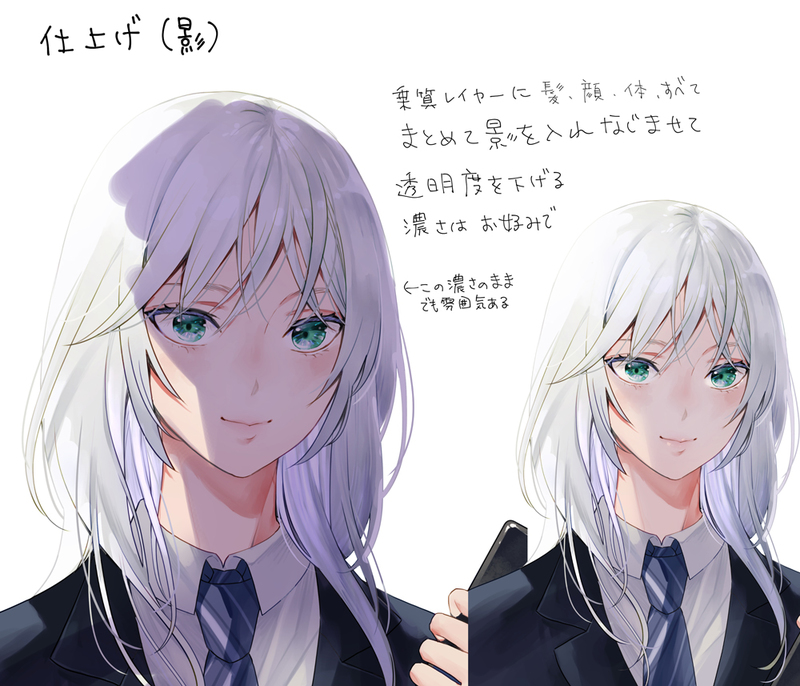
(Source: https://ichi-up.net/2020/15)
As well as the following.
"On a Hard Light layer, paint a color with high saturation (usually red for skin) on the boundary where light and shadow meet."

(Source: https://ichi-up.net/2020/15)
She's talking about SSS; Sub-surface Scattering. This is a lighting and coloring technique where when light seeps through a surface, it carries that subject's color through the shadow until a certain range. You'll see it when you put a flashlight against your hand and see the red of your flesh shine through the opposite end.
Example:

(Source: bgates87 (lmao))
As you can see, there's a highly saturated red, right at the boundary between where hard light hits, and the shadow begins. This does not always have to apply, especially when the light isn't that strong, but it is a huge factor in establishing a strong lighting effect.
It also doesn't have to be red; it's only red because the subject is human skin in the previous examples. Try to imagine what color would permeate the shadows of a blue water balloon, or on a tree surrounded by green or even orange leafs.
No unique ability usage for us that I can think of this time, as it's relatively straight-forward.
Now... onto my favorite part...
#6 - Color Theory (BOSS FIGHT!!) Rainbow Slime (Lv. 6)
Hahaha. Where do I even begin?
Color theory conveys the idea that certain zones of the color wheel, and particular color combinations at specific angles and ranges result in colors that will always be visually and emotionally pleasing to the human eye. It is almost objective, which doesn't exist in art, but if you pull off color theory from the beginning, something can look good even if the rest of the illustration looks like shit, basically. That is the power of this fundamental, and many people tend to overlook it, especially in the beginning.
In fact, we even have professionals who don't know color theory. Of course, it's an artist's decision whether or not to incorporate it into their art, and there are some cases where it doesn't work, such as when someone wishes to use darker, less saturated colors to convey more of a purposely dull and somber atmosphere. Nevertheless, it is still incredibly important to know, and among an artist's strongest weapons (and even stronger when it's us who wield it)
Allow me to provide a few general example combinations of color theory.
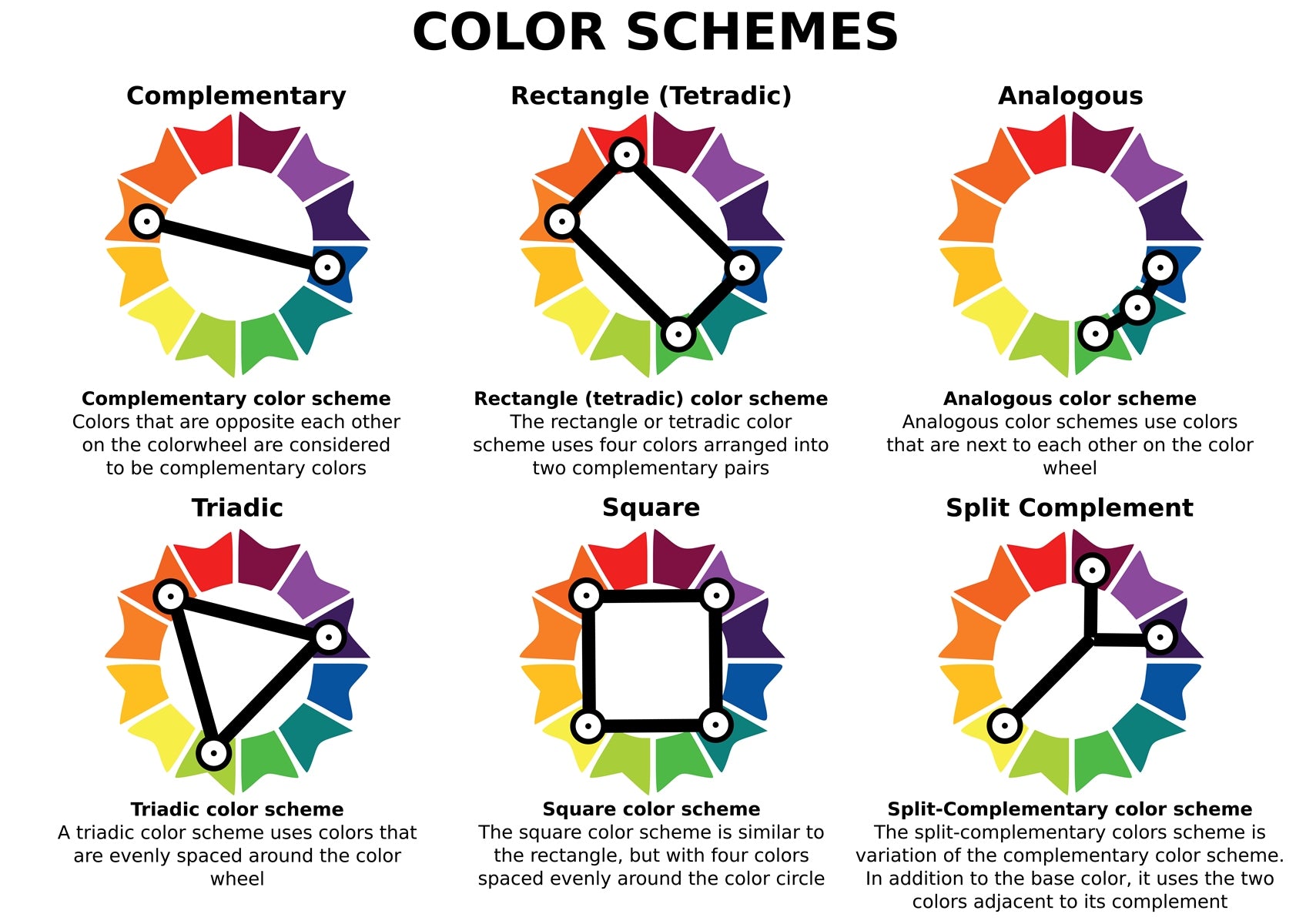
(Source: ...the web)
At first sight, it might be daunting to see how many different types of colors we can use in our art, for different kinds of moods and feelings. As we out of all people should know, different colors have different properties, and each resonate a particular feeling or quality. What's interesting, though, is that this can even be felt by normal humans, because all humans have a deep, primal, spiritual connection to colors due to our chakras and soul, as the soul is made of light and color is how light is broken down for our vision to perceive, all this be known or not to regular people.
Meaning you can evoke any intended atmosphere or feeling in your illustration through mastery over color theory, allowing you to basically control what emotions you want the viewer to feel when they look at it, through the usage of the colors in your drawings. It's fucking crazy if you think about it. Let this be a major upgrade to your skill level and stats.
Earlier, I showed several of the main color combinations. Truth is, even I haven't used half of those, and coloring is my strongest area. You can eventually try them all out if you wish, for experience, and see which one suits a particular scheme that you resonate with, but the bottom line is: you can get away for eternity with really just the Triadic and Complementary type. Or two others of your choice. That's all there is to it, for the most part.
For beginners, when you're shading and coloring your illustration (on a Multiply layer), as long as you shade with a color that is 1/3rd counter-clockwise to the base color, you're done.
Here's a simpler version of color theory that may be of benefit to those who prefer starting out with something easier:

(Source: Youtube Thumbnail)
As you can see, we have warm colors, and cool colors. These are colors that our senses mostly attribute to what we perceive to be hot (red, yellow, orange), and cold (blue, green, and purple). This is the reason why red is considered lively, whereas blue can be sad or solemn.
Of course, the effects of a color depends on many different factors, such as the saturation level, surrounding colors, which "side" of the color (dark, mossy green towards blue, or bright, happy green towards yellow), but as I said, this is simply to establish some basic understanding for one who is just starting out.
Nothing is ever just it on its own, in art; everything is subjective, and can change as a result of anything else in the illustration.
Unique ability usage: Before coloring your painting, or starting your drawing for that matter, void meditate and begin to feel what kind of emotions you wish to spill into your drawing. The emotions you feel and the sensations that arise, will define what kind of color scheme and the levels of saturation, contrast, etc. you can use to convey such emotions to the fullest. I personally have had people physically jolt and experience chills from some of my most strongly colored works, as a result of the emotions I cascaded into it; it was tangible to even normal people.
Conclusion
As I mentioned in the beginning of this long post, many of us possess a creative desire to try drawing and painting, but might not quite know where to begin. I believe that the creative potential we possess as not just humans, but Spiritual Satanists, must be allowed to be expressed through a medium that pertains to our desires, and allows us to evoke that which resides in our hearts and creative minds.
If that happens to be the path of illustration, I dearly, strongly hope with all my soul that one of you may pursue and find your path as an illustrator as a result of this post I made. From the effort I finally stuck into helping people with my knowledge here. I mean that with all my identity.
There are one or two more fundamentals I may have forgotten, but with these six, a beginning artist right out of the gate should be able to start working on developing everything they need. It is also important to note, that these fundamentals, all in combination are what will eventually perfect your artistic abilities.
Leaving or skipping them out will lead to breaks and gaps in your output, even as someone advanced and above; I've experienced this myself, and have had to return to fix these very basics I just laid out for new artists.
Although this might sound somewhat overwhelming, everything I wrote in this post, is actually only a glimpse of all else I still have to say. Remember, this was just a guide for beginners, LOL.
Upon defeating the Rainbow Slime, and grinding all the fundamentals for maybe a year (or two), I will welcome you to the next chapter, where much more awaits you as an intermediate artist by then. And beyond that, you can only guess what else...
Thank you so much for reading everything; it took me 10 hours to write all of this. May you advance in not just art, but spiritual powers as well, the very ones we can use to rapidly accelerate our growth in this field, using our mind's abilities.
If there is anything anyone wishes to ask me, or if there are already experienced artists who wish to request guides for higher level issues, please tell me about what struggles you may be facing in art, and I might create new threads on some of the most common walls we all face as artists.
Powerofjustice's recent thread regarding the concept of giving and taking, has allowed me to come to the realization that I have very much held back from providing the knowledge I possess in my area of expertise, to the forums for many years.
However, with the recent creation of this sub-forum of Art & Music, I may now finally have a place to contribute the knowledge and experience I've accrued over my years, towards helping our community learn and develop in my own field of passion, that being art.
Specifically, digital illustration of human characters, and backgrounds. Nevertheless, the same knowledge and fundamentals also apply to traditional art (pencil & paper, watercolor, markers etc), and even other genres of drawing (mechas, animals, probably...). Interestingly enough, most of us started on paper before moving onto digital art, and there are still many professionals among us who sketch on paper and then scan and finalize their art digitally.
As you may or may not have seen me before on these forums, please allow me to provide an in-depth and definitely not vague introduction before I commence the deluge of information I'd been anticipating to share here for over 4 years.
Mook, Artist.
Now that we've totally gone over the full details of my entire identity, let me explain to you the absolute fundamentals of art that a beginning artist must focus on, at the very start of their eternal adventure that is the expression of our emotions and soul. Many artists in the beginning may possess a strong desire to begin learning illustration, but do not know how, or where to start. Surely, they wouldn't even have a painting program or a digital illustration device for it.
However, as I mentioned earlier, mostly all of us started with pencil and paper, and since the fundamentals are the same, it will actually carry over into digital art, once you get past the initial potential discomfort of using a pen and tablet, if you ever choose to go digital.
If you happen to like RPG games, think of art like an online RPG. Everyone starts with default equipment corresponding to their class, and everyone chooses their own path. Some branch out to different kinds of art, like music, or literature. Even in those different sectors of art, there's many genres of it underneath.
For example, illustration: Western comic style, Eastern anime/manga style, human characters, robotic/mechanical characters, creatures, etc.
Music: Rock, Jazz, Orchestra, etc.
Literature: Horror, mystery, romance, etc.
Since we're all literal mages in real life here, let's just say we're generally the Magician class as artists. It's very suiting, too, since the entire idea of art is to manifest in reality that which we express emotionally and psychologically, and from the soul level. What type of Magician you want to attribute your artistic identity to, I leave that to you.
With that said, let me introduce you to some of the fundamentals that will form as a basis for everything you do as you progress in your art journey. Spiritual Satanist is a very special mage class, and we have hidden, unique abilities that can help us in the acquisition of knowledge, and maybe even gain more EXP (and faster) compared to "normal" classes, or even "regular" mages...
The Fundamentals of Art (The Plains of Beginnings!)
#1 - Gesture Drawing (Slime) (Lv.1)
First and foremost, without exception, for the most part: Gesture/figure drawing. Figure drawing is the act of observing a pose from a photograph, and attempting to comprehend its forms of dynamism and movement through usage of the "line of action" (an imaginary line that runs through any pose, static or moving), and loose shapes such as circles and ovals to roughly represent parts of the body.
Understanding the flow of the human body in different poses from the very beginning, and how to capture it, ultimately already saves you from the first novice trap of trying to draw things without construction or dynamism.
The key to practicing and comprehending this, is to repeatedly perform figure drawing as a regular warm-up, under 2 minutes or less. As you become used to this process, you should aim to be able to mostly draw a loose pose of which the action you can visibly identify by its flows alone, within 30 seconds.
Here is an example depicting the concept of flow in poses.
Translation: What is the flow of the body?
(left) No flow
(right) with flow.
(Bottom text) Expressing the flow is important when posing!

(Source: Palmie.jp (https://www.palmie.jp/lessons/267)
There are many sites out there designed for artists to practice figure drawing. Personally, the two sites I've used for years where I have been able to effectively practice figure drawing, are Line of Action, and PoseManiacs. The former uses real photographs, the latter uses anatomical models, which I'll mention again later in this post.
An example of using photographs as reference when practicing figure drawing and poses:

Source: Pinterest
(Personal experience: I remember in the beginning, my first sketch with zero fundamentals took 6 hours and looked like splattered shit. I used all my mana just to defeat a slime that only gave 1 EXP, basically. Don't be like me. Always start from fundamentals)
Unique ability usage: Activate your third eye and tap into intuition as you observe the poses, and "feel" the flow. Every one of us sees and starts drawing from different parts of the pose, and constructs it differently. One of the most crucial elements of learning is intuitively discovering a method that suits you, individually, and our abilities help us understand ourselves enough to find exactly which way works best personally.
Also, understanding of gesture and shape applies to anything, not just humans:

(Source: https://ichi-up.net/2019/30)

(Source: The Virtual Instructor)
#2 - Construction and 3d shapes (Rock Elemental) (Lv.2)
Here is an example portraying how the human body can be simplified into a combination of several different 3d shapes:

(Source: Clip Studio Paint tutorials)
The human body and any targeted subject, is constructed of complex forms that can be visually simplified and broken down into 3d shapes. For example, the head, torso and pelvis during the construction phase can generally be drawn as cubes, and the joints such as shoulders, elbows and knees simplified into spheres. The arms and legs, cylinders, and the hands and feet, as triangles, wedges or pentagons.
Once you understand how to visualize complex objects and structures as a combination of cubes, cylinders, spheres, cones and rectangles, and many other different 3d shapes, you can begin creating relatively comprehensible mannequins of humans, and anything else you wish to draw. As you become used to it, you'll realize most areas of the body or subject don't precisely conform to a certain shape. In these cases, like carving out a block, you gradually shape it into the part you intend to draw, as it begins to resemble your target more and more.
To familiarize yourself with drawing 3d shapes, try to draw all sorts of shapes and connect them on top or aside one another to obtain a feel as to how you might draw a real object in the future. Remember, everything can be simplified to a bunch of interconnected, stacked 3d objects. A closet, for example, is a rectangle with smaller rectangles for the handles. A door is a rectangle with a smaller rectangle and sphere for the doorknob.
Unique ability usage: After vividly observing the photograph of the subject (remember to use references), human or otherwise, close your physical eyes and use your astral sight to attempt to reconstruct what you just saw, as three-dimensional shapes. Entirely replicating what you see can be too hard at first and is also not the point here, so using your astral vision forces you to comprehend and construct something while also using both your creativity and intuition, as they tell you what stands out the most to you, and how to recreate it.
Construction will also help in visualizing things in perspective, which leads us to the next fundamental.
#3 - Perspective (Wind Elemental) (Lv.3) (Arguably level 666 or something once you cross into advanced levels...)
Perspective is the construction of the surrounding environment in which the subject is depicted, and also the space and distance perceived based on what is shown to be nearer, and farther away to the viewer. ...Yeah. This is a monster that scales with your own level, so it will almost always be difficult regardless of your level of advancement.
For now, let's just talk about how perspective can be incorporated into drawing characters. Backgrounds and the like are for the next chapter zone.
Understanding perspective is fundamental in depicting your subject in both a convincing and visually appealing manner, as we begin to include how the viewer visually perceives the subject in space, and this can possess a major impact in the expressiveness and mood of the illustration. You may have heard of foreshortening, which is typically when part of the character seems to reach out towards the viewer, like their hand, or foot. This is already somewhat advanced usage of perspective on the character alone, excluding how perspective can be used for backgrounds and the like, too.
Similarly to film and photography, a character viewed from somewhat far away can create a feeling of distance, or isolation. Whereas a close up, perhaps diagonal shot of the character's face can be much more impactful and dramatic in conveying their emotions, and expression. This is one example of the usage of perspective to convey different moods.
Here is an example displaying how different angles of the same general action and character, can create very different expressions depending on the artist's usage of perspective:

(Source: Wacom tutorials)
One way to familiarize oneself with incorporating perspective into one's illustrations, is to practice drawing 3d shapes and objects in different angles. Eventually, you will want to apply this to poses, and try to draw the same pose at 3 different points of view . This will also massively help later on, where you're drawing out random ideas and then choose 1 to finalize into a full illustration.
What we know as a "focal point" is the focus of the scene, towards which our eyes are drawn first and foremost, and what we wish to present to the viewer as the main subject of interest. This can be anything that serves as the center of attention amidst the rest of the scene. This could be the face, eyes, the weapon reaching out towards the viewer, etc.
In the case of my own art, it's often the chest and butt HAHAHAHA (oh, fuck...)
Unique ability usage: When you're drawing a pose from different angles, you can, once again, actually use your astral vision to surmise what something would look like from a different perspective. Not just see, but if you use Merging Consciousness, you can actually feel and experience anything you want.
This is really, really hard for normal people, but we've undergone the spiritual training to gain these abilities, which grants us a massive edge over anybody. (Something even harder is to feel yourself in the pose and sense where the centre of gravity leans the skeletal structure to determine the flow of the spine, angle of the hips, and positions of the feet, but that's some next level shit...)
Of course, you should still use references when you can, and a tip for poses is to use 3d models that you can turn around and see from other angles. Effective sites for this are PoseManiacs once again, and surprisingly, SketchFab.
SketchFab is actually supposed to be used to purchase 3d models, but we're really just using it to inspect stuff and practice drawing. You can search for something, click something you like, and turn it around at different angles, zoom in and practice for all your studies.
#4 - Anatomy (Wooden Training Doll) (level 4)
With the previous fundamentals, especially #2, construction, learning anatomy actually becomes a lot easier than it might seem. Some (many?) of us already have experience in physical training and/or martial arts, or even TCM (Hi, Blitz!), so we might be more familiar with the muscular system.
Regardless, when we research the muscular and skeletal structures of the human body for artistic purposes, we can simplify areas of the body into simpler shapes, that help us understand the structure to a more easily comprehensible degree. However, the difference with actually knowing anatomy, is that simplification is really for the purposes of establishing an initial understanding of the complexity of the human body. Most of us do not stop at the simplification, but carve and detail it further to resemble the muscles we intend to draw.
Here's an example of a color-coded portrayal of the muscles in the forearm. Previously, one might have simplified the forearm as a cylinder or bottle shape, but as we can see, there's a lot more going on inside.

(Source: Pinterest)
Now, you might be thinking, "Remembering muscles sucks. Do I really need to know anatomy to draw characters?"
Actually, no, you don't. One of us in my field was a woman who is a professional artist, and hadn't picked up an anatomy book until she was in college (but she still did in the end, right?). She had gone by shapes and construction entirely, and the rest of the fundamentals, without really knowing muscular structure or anything of the like. So technically, no, you actually don't need to know anatomy in order to draw characters (to an extent).
However, you are in my opinion crippling yourself when it eventually comes to situations where you might wish to vary the kinds of characters you draw, or the extents of detail you wish to draw their body at, which also depends on the genre and theme of your art.
More realistic styles such as those often seen in horror, action, and sexual art, where there is much emphasis on the body and details included, do absolutely require anatomical knowledge in order for the intended atmosphere or resonance to be conveyed in a convincing manner towards the viewer.
Even potentially more simple art styles, where the intention is to portray a fragile, cute character, the artist still possesses the actual anatomical knowledge most of the time, but specifically decides to simplify it for the sake of the target resonance of the character. If they didn't have the knowledge in the first place, every character would generally have the same body type, including characters of the opposite gender.
Basically, learning anatomy is for the sake of understanding the structure beneath that which you see, and will only further enhance your comprehension of whatever characters you intend to draw, adding more opportunities and variation. It's a very useful skill, and you could purposely choose not to use it, but having it and not using it is different than straight up not having it!
Since we're talking about drawing human characters, it would be to our benefit to understand the structure of the human body. When you feel like you have attained a comprehensive understanding of muscular anatomy, try studying the skeletal structure, as well. Muscles are connected to the skeleton, after all! This will also help in gesture drawing and posing, to understand how the muscles of the body stretch and turn, resulting in some very natural, beautifully dynamic poses.
PoseManiacs has a function where you can toggle color-coded appearances of the muscles when viewing the anatomical models, allowing for easier visibility. We didn't have this back when I started, so make the most of it!
#5 - Lighting and Shading Dark/Light Elemental (Lv. 5)
Another important fundamental in art, is the understanding of light and shadow. Lighting and shading allows us to establish vivid form and dimension in a subject, and it is what allows it to feel as though it truly looks to be present, despite it being in a 2-dimensional illustration. Essentially, it gives form and a sense of realism to something.
Here is an example of the basics of lighting and shading upon a sphere:

(Source: Pinterest)
Plainly, shadow is where light does not reach, but this is actually not entirely true. When light shines onto another surface or color in the immediate environment, the light that bounces off of it can actually seep into the shadow as a colored form of light, and this is called bounce light, or reflected light. Although black and white, you can see the slight, soft arc of light around the outer edge of the shaded area despite it being the opposite side of the light source. If you were to imagine a pearl on a metal surface, you would see a similar effect.
Now, since a sphere is round, the light that shines upon it will disperse across its curved surface, causing the shadow to resemble a gradient of light and shadow, rather than a sharp, abrupt transition as would occur with a cube.
To familiarize yourself with lighting and shading, practice drawing and shading several 3d shapes such as spheres, cubes, cones, and rectangles. You will quickly come to understand how light and shadow appear differently (or similarly) on each of these shapes, such as in the following example:

(Source: Pinterest)
As well as here:

(Source: Pinterest)
When you've become familiar with shading 3d shapes, you can move towards applying lighting and shading techniques onto characters, starting from the face, hair, and body. When you begin applying shadows to characters, you will discover the interesting effect that shading has on the overall impact, and mood of the expression and scene...
Although the examples from here on out are of digital art and coloring, the same elements of color, light and shadow apply to traditional art, as well. This is visible in many old, famous paintings of realistic portraits.

(Source: Pinterest)
The following example is part of a guide on a Japanese site and includes some notes. I'll provide translation.
(The images are from right to left; right being before, and left being after applying shading.)
"On a Multiply layer, cover the hair, face, body, everything and blend the shading, then reduce transparency. Reduce level of shading wherever you like."
(arrow) "Reducing it like this over here, adds a sense of atmosphere" (which it does; the power of bounce light. That slight, lighter purple could've been blue to add a sense of general air or sky, but this is entirely up to the artist's intentions)

(Source: https://ichi-up.net/2020/15)
As well as the following.
"On a Hard Light layer, paint a color with high saturation (usually red for skin) on the boundary where light and shadow meet."

(Source: https://ichi-up.net/2020/15)
She's talking about SSS; Sub-surface Scattering. This is a lighting and coloring technique where when light seeps through a surface, it carries that subject's color through the shadow until a certain range. You'll see it when you put a flashlight against your hand and see the red of your flesh shine through the opposite end.
Example:

(Source: bgates87 (lmao))
As you can see, there's a highly saturated red, right at the boundary between where hard light hits, and the shadow begins. This does not always have to apply, especially when the light isn't that strong, but it is a huge factor in establishing a strong lighting effect.
It also doesn't have to be red; it's only red because the subject is human skin in the previous examples. Try to imagine what color would permeate the shadows of a blue water balloon, or on a tree surrounded by green or even orange leafs.
No unique ability usage for us that I can think of this time, as it's relatively straight-forward.
Now... onto my favorite part...
#6 - Color Theory (BOSS FIGHT!!) Rainbow Slime (Lv. 6)
Hahaha. Where do I even begin?
Color theory conveys the idea that certain zones of the color wheel, and particular color combinations at specific angles and ranges result in colors that will always be visually and emotionally pleasing to the human eye. It is almost objective, which doesn't exist in art, but if you pull off color theory from the beginning, something can look good even if the rest of the illustration looks like shit, basically. That is the power of this fundamental, and many people tend to overlook it, especially in the beginning.
In fact, we even have professionals who don't know color theory. Of course, it's an artist's decision whether or not to incorporate it into their art, and there are some cases where it doesn't work, such as when someone wishes to use darker, less saturated colors to convey more of a purposely dull and somber atmosphere. Nevertheless, it is still incredibly important to know, and among an artist's strongest weapons (and even stronger when it's us who wield it)
Allow me to provide a few general example combinations of color theory.

(Source: ...the web)
At first sight, it might be daunting to see how many different types of colors we can use in our art, for different kinds of moods and feelings. As we out of all people should know, different colors have different properties, and each resonate a particular feeling or quality. What's interesting, though, is that this can even be felt by normal humans, because all humans have a deep, primal, spiritual connection to colors due to our chakras and soul, as the soul is made of light and color is how light is broken down for our vision to perceive, all this be known or not to regular people.
Meaning you can evoke any intended atmosphere or feeling in your illustration through mastery over color theory, allowing you to basically control what emotions you want the viewer to feel when they look at it, through the usage of the colors in your drawings. It's fucking crazy if you think about it. Let this be a major upgrade to your skill level and stats.
Earlier, I showed several of the main color combinations. Truth is, even I haven't used half of those, and coloring is my strongest area. You can eventually try them all out if you wish, for experience, and see which one suits a particular scheme that you resonate with, but the bottom line is: you can get away for eternity with really just the Triadic and Complementary type. Or two others of your choice. That's all there is to it, for the most part.
For beginners, when you're shading and coloring your illustration (on a Multiply layer), as long as you shade with a color that is 1/3rd counter-clockwise to the base color, you're done.
Here's a simpler version of color theory that may be of benefit to those who prefer starting out with something easier:

(Source: Youtube Thumbnail)
As you can see, we have warm colors, and cool colors. These are colors that our senses mostly attribute to what we perceive to be hot (red, yellow, orange), and cold (blue, green, and purple). This is the reason why red is considered lively, whereas blue can be sad or solemn.
Of course, the effects of a color depends on many different factors, such as the saturation level, surrounding colors, which "side" of the color (dark, mossy green towards blue, or bright, happy green towards yellow), but as I said, this is simply to establish some basic understanding for one who is just starting out.
Nothing is ever just it on its own, in art; everything is subjective, and can change as a result of anything else in the illustration.
Unique ability usage: Before coloring your painting, or starting your drawing for that matter, void meditate and begin to feel what kind of emotions you wish to spill into your drawing. The emotions you feel and the sensations that arise, will define what kind of color scheme and the levels of saturation, contrast, etc. you can use to convey such emotions to the fullest. I personally have had people physically jolt and experience chills from some of my most strongly colored works, as a result of the emotions I cascaded into it; it was tangible to even normal people.
Conclusion
As I mentioned in the beginning of this long post, many of us possess a creative desire to try drawing and painting, but might not quite know where to begin. I believe that the creative potential we possess as not just humans, but Spiritual Satanists, must be allowed to be expressed through a medium that pertains to our desires, and allows us to evoke that which resides in our hearts and creative minds.
If that happens to be the path of illustration, I dearly, strongly hope with all my soul that one of you may pursue and find your path as an illustrator as a result of this post I made. From the effort I finally stuck into helping people with my knowledge here. I mean that with all my identity.
There are one or two more fundamentals I may have forgotten, but with these six, a beginning artist right out of the gate should be able to start working on developing everything they need. It is also important to note, that these fundamentals, all in combination are what will eventually perfect your artistic abilities.
Leaving or skipping them out will lead to breaks and gaps in your output, even as someone advanced and above; I've experienced this myself, and have had to return to fix these very basics I just laid out for new artists.
Although this might sound somewhat overwhelming, everything I wrote in this post, is actually only a glimpse of all else I still have to say. Remember, this was just a guide for beginners, LOL.
Upon defeating the Rainbow Slime, and grinding all the fundamentals for maybe a year (or two), I will welcome you to the next chapter, where much more awaits you as an intermediate artist by then. And beyond that, you can only guess what else...
Thank you so much for reading everything; it took me 10 hours to write all of this. May you advance in not just art, but spiritual powers as well, the very ones we can use to rapidly accelerate our growth in this field, using our mind's abilities.
If there is anything anyone wishes to ask me, or if there are already experienced artists who wish to request guides for higher level issues, please tell me about what struggles you may be facing in art, and I might create new threads on some of the most common walls we all face as artists.



